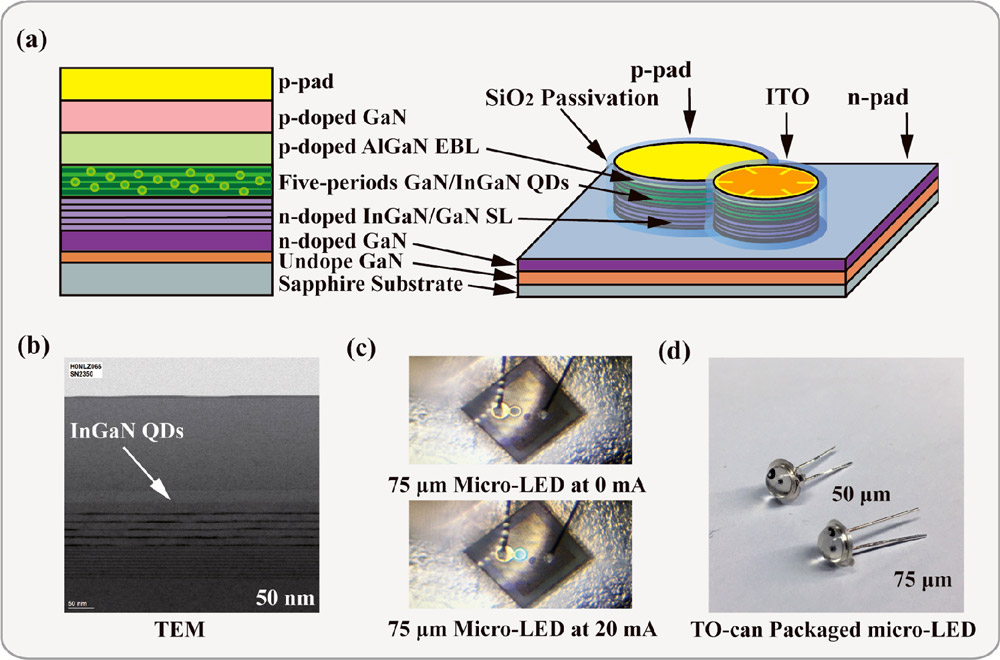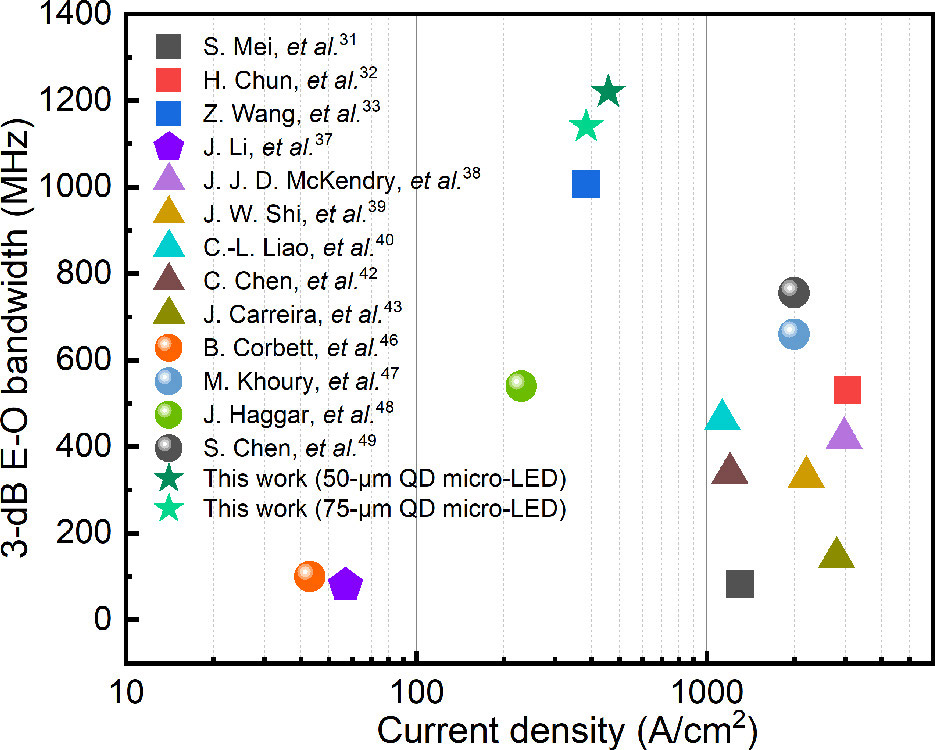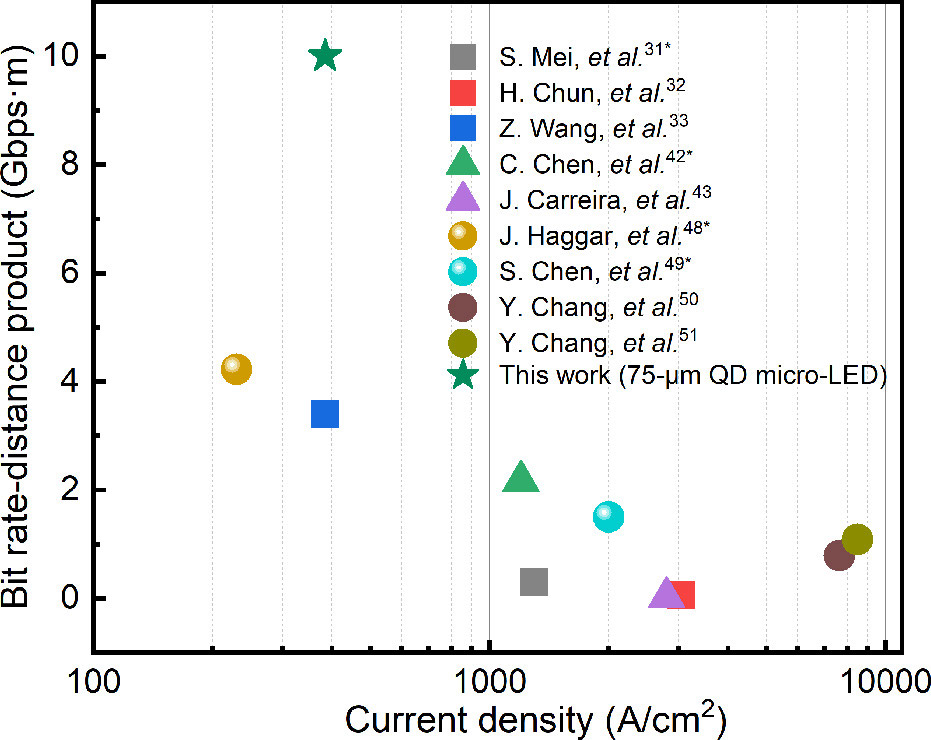News: LEDs
8 July 2022
Green QD micro-LED multi-Gbps visible light communication
Researchers based in China and Taiwan report record visible light communication (VLC) performance for quantum-dot micro-sized green light-emitting diodes (QD micro-LEDs) Zixian Wei et al, ACS Photonics, published online 22 June 2022].
The team from Tsinghua University, Hong Kong Polytechnic University, Harbin Institute of Technology Shenzhen, China, and National Tsing Hua University, Taiwan, comment: “The proposed VLC system has achieved a real-time distance-rate product of 4.2Gbps-m and an offline distance-rate product of 10Gbps-m, which should be further emphasized as the highest record of all the VLC systems based on the single-pixel green LED, to the best of our knowledge.”
Further, one QD green micro-LED achieved a claimed record data rate for a single green LED-based point-to-point real-time non-return-to-zero on-off keying (NRZ-OOK) VLC system of 2.1Gbits/s (Gbps) with a bit-error rate (BER) of 2.7E-3.
VLC is being proposed for near-field communication (NFC) for downlink or optical device-to-device (D2D) links. Heterogeneous high-speed VLC could use multi-color micro-LEDs in converged illumination, positioning, display, and communication systems. It can be deployed in free-space and underwater optical wireless communication (UOWC) formats.
The team comments: “There is an evolution using a LED array to provide a higher emitting optical power while maintaining the high modulation bandwidth. For the trade-off between single-pixel LED and LED array, we consider the latter is more promising because it can provide more illumination coverage or communication distance for actual VLC applications in a specific space.”
Higher signal power from array formats could find deployment in intersatellite links, structured light positioning, and multiuser VLC access.
The team describes some of the trade-offs for designing high-bandwidth LEDs: “As the size of the LED decreases, the current density increases and directly leads to an increase in the E-O bandwidth, but at the same time, the effect of sidewall defects also increases, accompanied by a larger leakage current. These factors also restrict E-O bandwidth from increasing indefinitely by shrinking the size.”

Figure 1: (a) Epitaxial and single-pixel QD micro-LED structure. (b) Transmission electron microscope images of green V-W mode QDs. (c) Packaging of QD micro-LED at 0mA and 20mA injected currents, respectively. (d) Corresponding TO-CAN macro picture with front lens of 50μm- and 75μm-diameter QD micro-LEDs.
The indium aluminium gallium nitride (InAlGaN) epitaxial material for the QD micro-LEDs (Figure 1) was grown on 2-inch sapphire, using metal-organic vapor phase epitaxy: the undoped GaN buffer was 1μm thick; the n-GaN contact layer 3.5μm; the n-InGaN/GaN superlattice (SL) pre-strain layer 10x(3nm/3nm); the p-AlGaN electron-blocking layer (EBL) 20nm; and the p-GaN contact 180nm.
The active light-emitting QD region was grown in a Volmer-Weber (V-W) self-assembly mode, using a precursor-alternate-admittance method followed by growth of the upper InGaN layer. The QDs were typically 2-3nm high.
LED fabrication began with inductively coupled plasma etch of a gourd-shaped mesa. The light-emission window p-contact region was covered with indium tin oxide (ITO) transparent conductor. The sidewalls were passivated with plasma-enhanced chemical vapor deposition silicon dioxide (SiO2).
After application of the p- and n-type metals, the devices were packaged in TO-cans, encapsulated in epoxy resin. The lens-shaped epoxy gave a slight convergence to the emitted light, along with protecting the devices from dust particles.
Measured carrier life-times in the QD material were as short as 560ps, “owing to a weak QCSE and small QD sizes”, according to the team. The quantum-confined Stark effect (QCSE) from charge polarization fields is a key impediment to fast modulation in III-N-based LEDs.
The emission wavelengths varied with current injection and micro-LED size between 492nm and 496nm. The smaller 50μm-diameter device tended to emit slightly shorter wavelengths, and the 75μm LED slightly longer wavelengths up to 40mA injection. The wavelengths blue-shifted up to around 20mA, and after that the tendency was in the red direction.
At 50mA, the light output powers were 180μW and 100μW for the 75μm- and 50μm-diameter LEDs, respectively.
The smaller 50μm device achieved a 1.22GHz 3dB bandwidth at 458A/cm2 current density (Figure 2). The larger device had a slightly smaller bandwidth of 1.14GHz at 385A/cm2. The electrical-to-optical (E-O) bandwidth of transmission over hard polymer-clad fiber reached 1.3GHz at 509A/cm2 for the smaller device.

Figure 2: Benchmarks of 3dB E-O bandwidth of long-wavelength LEDs versus various current densities (square symbol: white-light LED; pentagon symbol: surface plasmon-coupled LED; triangle symbol: c-plane LED; sphere symbol: semipolar green LED; star symbol: QD green micro-LED in work reported here).
The devices were used in real-time NRZ-OOK and offline pulse-amplitude modulation four-level (PAM-4) experiments over a 2m free-space link.
Although the smaller device showed superior performance in small-signal measurements, the weaker emitted power was a problem in terms of the signal-to-noise ratio (SNR). The team therefore used the 75μm device in the modulation experiments.
The BER decreased as the device bias increased to 6.5V, giving a current density injection of 385A/cm2. At that bias, the device could transmit a 2.1Gbps before the forward error correction (FEC) BER limit of 3.8E-3 was reached.
Higher bias levels would result in more heat generation, a problem given the poor thermal dissipation capability of the TO can package, leading to earlier device breakdown.
The PAM-4 modulation experiments using a Volterra equalizer and a series offline digital signal processor (DSP) managed to reach 5Gbps data rates without breaking the FEC limit. At 407.45A/cm2 and 452.72A/cm2 current density, the BERs at 5Gbps were 3.6E-3 and 1.9E-3, respectively. The corresponding SNRs were 14.07 and 15.14.

Figure 3: Benchmarks of bit rate-distance product of VLC systems based on long-wavelength single-pixel mini/micro-LEDs or mini/micro-LED arrays versus current density (square symbol: white-light LED; triangle symbol: c-plane LED; sphere symbol: LED; round symbol: semipolar green LED array; star symbol: QD green micro-LED in reported work. * Specific values of the propagation distance are lacking, which are reasonable to assume to be around 1m).
The researchers were unable to go beyond 5Gbps due to the limitations of their arbitrary waveform generator (AWG) equipment. The offline 10Gbps-m distance-rate product was benchmarked against other reports (Figure 3).
QD micro-LEDs InGaN VLC AlGaN GaN
https://doi.org/10.1021/acsphotonics.2c00380
The author Mike Cooke is a freelance technology journalist who has worked in the semiconductor and advanced technology sectors since 1997.









